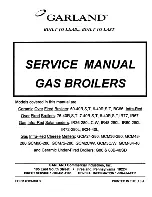
31
INS
TALLER
US
ER
MAINTEN
AN
CE TECHNI
CI
AN
3.4 CONVERTING THE BOILER
TO OTHER TYPES OF GAS.
If the boiler has to be converted to a different
gas type to that specified on the data nameplate,
request the relative conversion kit for quick and
easy conversion.
The gas conversion operation must be carried
out by an authorised company (e.g. Authorised
After-Sales Technical Assistance Service).
To convert to another type of gas the following
operations are required:
- disconnect the appliance;
- replace the nozzle located between the gas pipe
and gas/air mixing sleeve (Part. 16 Fig. 1-27);
- re-power the appliance;
- calibrate the number of fan revolutions (parag.
3.5):
- adjust the correct air/gas ratio (parag. 3.6);
- seal the gas flow rate regulation devices (if set-
tings are modified);
- after completing the conversion, apply the
sticker, contained in the conversion kit, near
the data nameplate. Using an indelible marker
pen, delete the data relative to the old type of
gas.
These adjustments must be made with reference
to the type of gas used, following that given in
the table (Par. 3.18).
3.5 CALIBRATION OF NUMBER OF FAN
REVS.
Attention:
Verification and calibration is neces-
sary, in the case of transformation to other types
of gas, in the extraordinary maintenance phase
with replacement of the PCB air/gas circuit com-
ponents or in the case of installations with fume
extraction systems, with horizontal concentric
pipe measuring more than 1 metre.
The boiler heat output is correlated to the length
of the air intake and flue exhaust pipes. This
decreases with the increase of pipe length. The
boiler leaves the factory adjusted for minimum
pipe length (1m). It is therefore necessary, espe-
cially in the case of maximum pipe extension, to
check the ∆p gas values after at least 5 minutes
of the burner operating at nominal heat output,
when the temperatures of the intake air and ex-
haust flue gas have stabilised. Adjust the nominal
and minimum heat output in the domestic hot
water and central heating modes according to
the values in the table (Par. 3.18) using the dif-
ferential manometers connected to the ∆p gas
pressure points (29 and 30 Fig. 1-27).
Access the configurations menu under the “SER-
VICE” item and adjust the following parameters
(Par. 3.8):
- boiler maximum heat output “P62”;
- boiler minimum heat output “P63”;
- maximum central heating output “P64”;
- minimum central heating output “P65”;
Below find the default settings present on the
boiler:
Hercules Condensing 26 3 ErP
P62
G20:
5060 (rpm)
LPG:
4400 (rpm)
P63
G20:
1240 (rpm)
LPG:
1140 (rpm)
P64
G20:
4700 (rpm)
LPG:
4100 (rpm)
P65
G20:
1240 (rpm)
LPG:
1140 (rpm)
Hercules Condensing 32 3 ErP
P62
G20:
4700 (rpm)
LPG:
4200(rpm)
P63
G20:
1260 (rpm)
LPG:
1160 (rpm)
P64
G20:
4700 (rpm)
LPG:
4200 (rpm)
P65
G20:
1260 (rpm)
LPG:
1160 (rpm)
3.6 ADJUSTMENT OF THE AIR-GAS
RATIO.
Calibration of the minimum CO
2
(minimum
central heating power).
Enter the chimney sweep phase without with-
drawing domestic hot water and take the se-
lector switches to minimum (turn them in an
anti-clockwise direction until "0" is seen on the
display). To have an exact value of CO
2
in the flue
gas the technician must insert the sampling probe
to the bottom of the sample point, then check
that the CO
2
value is that specified in the table,
otherwise adjust the screw (3 Fig. 3-3) (Off-Set
adjuster). To increase the CO
2
value, turn the
adjustment screw (3) in a clockwise direction
and vice versa to decrease it.
Calibration of the maximum CO
2
(nominal
central heating power).
On completion of the adjustment of the mini-
mum CO
2
keeping the chimney sweep function
active, take the heating selector switch to maxi-
mum (turn it in a clockwise direction until “99”
is seen on the display). To have an exact value of
CO
2
in the flue gas the technician must insert
the sampling probe to the bottom of the sample
point, then check that the CO
2
value is that speci-
fied in the table, otherwise adjust the screw (12
Fig. 3-3) (gas flow rate regulator).
To increase the CO
2
value, turn the adjustment
screw (12) in an anti-clockwise direction and vice
versa to decrease it.
At every adjustment variation on the screw 12 it
is necessary to wait for the boiler to stabilise itself
at the value set (about 30 sec.).
Hercules Condensing 26 3 ErP
CO
2
at nominal
output
(central heating)
CO
2
at minimum
output
(central heating)
G 20
9.40% ± 0.2
8.90% ± 0.2
G 30
12.00% ± 0.2
11.80% ± 0.2
G 31
10.60% ± 0.2
10.20% ± 0.2
Hercules Condensing 32 3 ErP
CO
2
at nominal
output
(central heating)
CO
2
at minimum
output
(central heating)
G 20
9.40% ± 0.2
8.90% ± 0.2
G 30
12.30% ± 0.2
11.90% ± 0.2
G 31
10.50% ± 0.2
10.30% ± 0.2
3.7 CHECKS FOLLOWING
CONVERSION TO ANOTHER TYPE
OF GAS.
After making sure that conversion was carried
out with a nozzle of suitable diameter for the
type of gas used and the settings are made at the
correct pressure, check that the burner flame is
not too high or low and is stable (does not detach
from burner);
N.B.:
all boiler adjustment operations must be
carried out by a qualified company (e.g. Author-
ised After-Sales Assistance).
















































